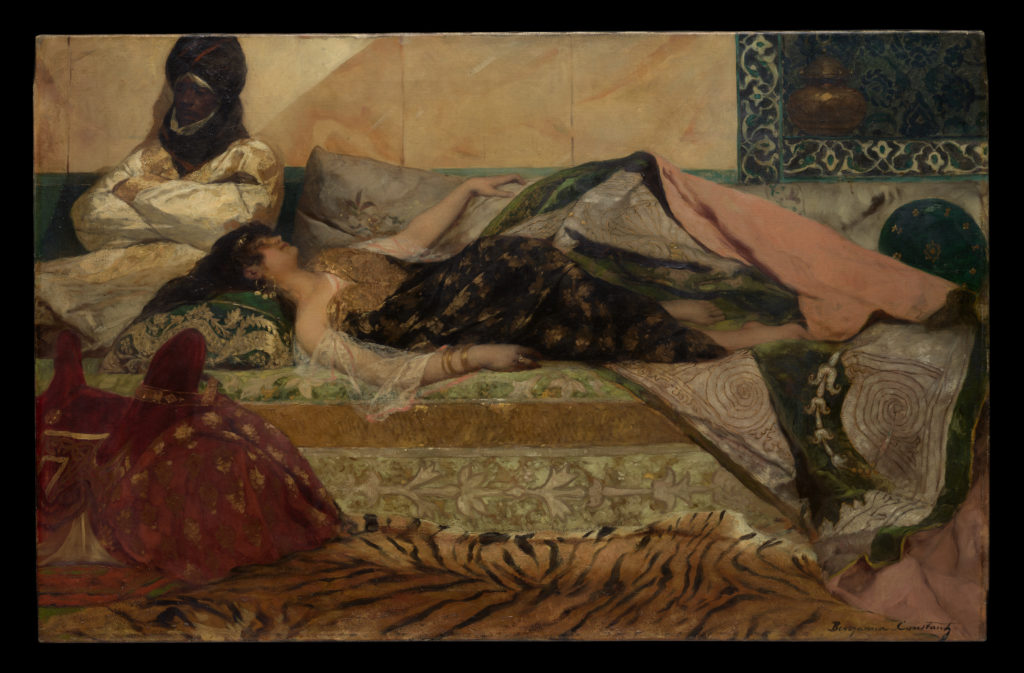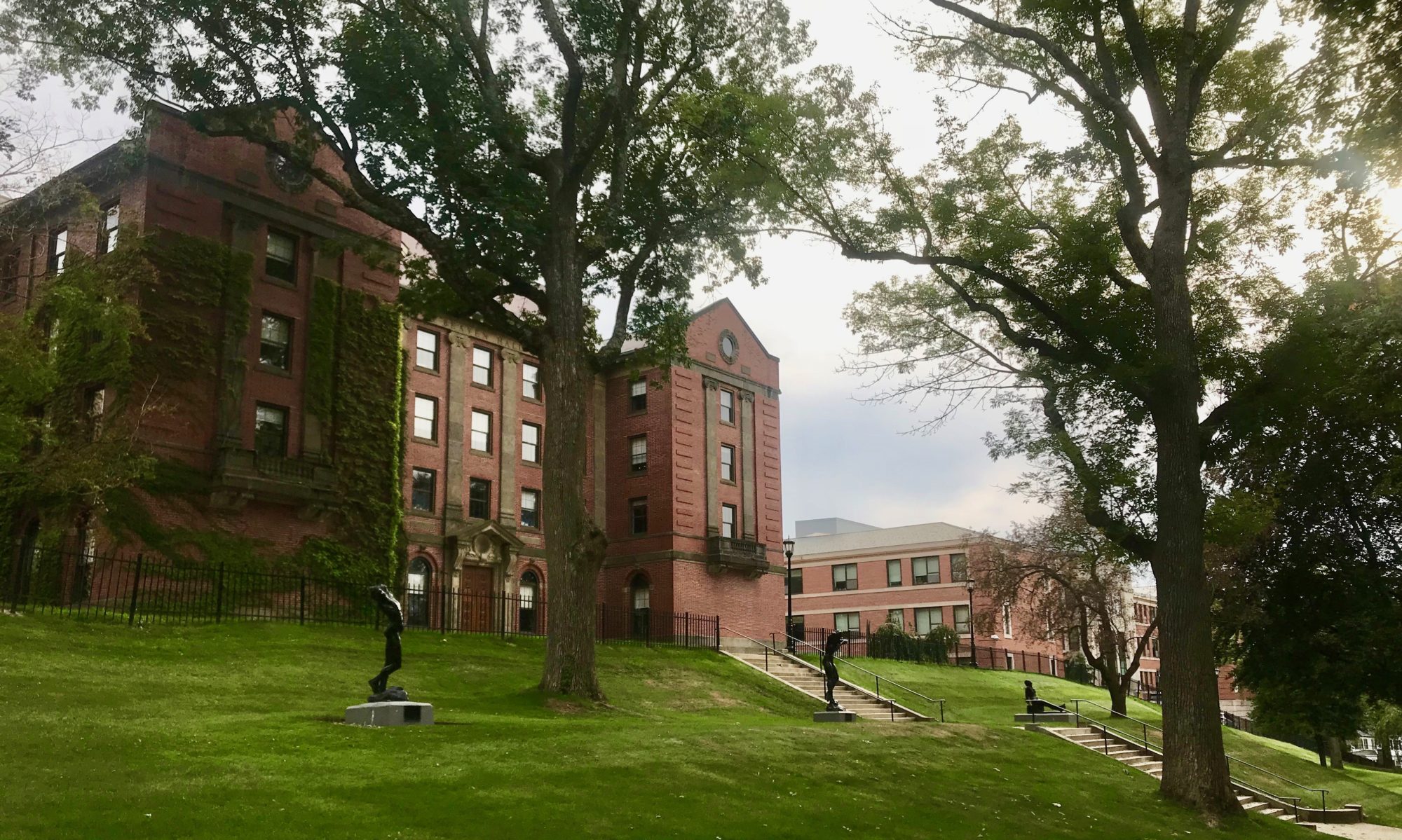Today’s guest blogger is Professor Emerita Virginia Raguin, who writes on Jean-Joseph Benjamin-Constant’s Entombment of Christ, currently in the Cantor Gallery collection.

Jean-Joseph Benjamin-Constant (1845-1902), born Jean-Joseph Constant, was a French painter and etcher best known for his orientalizing subjects and portraits. Although a native of Paris, he studied at the École des Beaux-Arts in Toulouse in the south of France. He quickly excelled at realistic anatomy, acquired from studying ancient statues, and dramatic composition from the replication of prestigious history paintings. He then transferred to the École des Beaux-Arts of Paris, studying under Alexandre Cabanel and was inspired by ancient history and the art of Delacroix and Rubens. This was a time of a highly prescribed series of competitions and awards. For an artist to achieve success, they needed recognition from the judges of the Salon, an official exhibition of the Académie des Beaux-Arts. Between 1748 and 1890 it was the most important professional and social event for art collectors of the world. Benjamin-Constant participated at the Salon of 1869 with romantic subjects with immediate success. Hamlet and the King (1867; Paris, Musée d’Orsay) showing Hamlet hesitating to kill Claudius while he is at prayer, was bought by the state (Dominique Lobstein in N. Bondil, ed., Benjamin-Constant: Marvels and Mirages of Orientalism [exh. cat., Montreal Museum of Fine Arts], Paris, 2014, pp. 36-38, no. 23). Afterwards, the artist was represented in the Salon almost yearly gaining most praise for works that exploited the dramatic function of light over equally dramatic subject matter.
Given the troubled atmosphere in Paris during the Franco-Prussian war, Benjamin-Constant joined with fellow artist Georges Clairin and Henri Renault to make an extended voyage through Spain and Morocco. Beginning in 1871, he resided for eighteen months in Morocco, a country where the French had gained considerable influence. The artist soon developed an oeuvre prioritizing Orientalism, a point of view emphasizing the exotic – and often the erotic – of the eastern culture. The paintings that he exhibited on his return to Paris met with great success; in 1878, Interior of a Harem in Morocco was acquired by the State for the Palais des Beaux-Arts in Lille; another Harem scene including half nude women, Les Chérifas (Musée de Beaux Arts, Carcassonne) received a medal at the 1884 Salon. With Jean-Léon Gérôme, Benjamin-Constant shared the place of Honorary President at the Society of French Orientalist Painters, whose inaugural exhibition was held in 1893. His undated Odalisque exemplifies his Orientalist bent, contrasting values of light and dark, and sophisticated handling of paint.

In the 1880s, Benjamin-Constant began painting monumental decoration including the wall of the Hall of the Capitol of Toulouse, the ceilings of the City Hall of Paris, the National Theater of the Opera Comique in Paris. In 1889, he painted murals for the home of Frederick Lothrop Ames, 306 Dartmouth Street, Boston (Ames-Webster House). Ames had commissioned John Sturgis to transform the home, which he did, creating a lavish wood panel reception hall. John La Farge designed the skylight installed in 1882 that exploited his newly developed “opalescent” glass technique. Benjamin-Constant’s mural cycle focused on the theme of the sixth-century emperor Justinian.

Here, the artist merged Venetian traditions of Renaissance narrative in the base with more hieratic depictions echoing Byzantine monumentality in the upper level. (Christopher Carlsmith, “The Byzantine and Venetian Cycles in the Boston Mansion of Frederick L. Ames,” in Benjamin-Constant: Marvels and Mirages of Orientalism, pp. 322-28).
The painting of the Entombment of Christ came to the College as a gift from the Cantor Foundation in 1980 and was for some time displayed in the office of President John Brooks. It can be identified as the oil listed as Entombment of Christ, about 1882, 60 x 81 cm (23 ½ x 31 ¾ in.) in the New York, Sotheby’s sale of June 12, 1980, lot. 58. Although less well-known, Christian subject matter was very much a part of the production of the artist, as well as his interest in grisaille, or monochrome (Benjamin-Constant: Marvels and Mirages of Orientalism, pp. 32-42). The depiction is remarkably sensitive. The artist harnesses his sensitivity to light and shadow to create an arresting image of the body of the Savior extended on the “stone of unction” that was venerated at the Holy Sepulcher in Jerusalem. He profiles a female mourner, head shrouded by a veil to the left – adjacent to the head of Christ. Behind, all is “nothingness.” Far to the right two men, Joseph of Arimathea and Nicodemus, tend to the body: “And after these things, Joseph of Arimathea . . . besought Pilate that he might take away the body of Jesus. And Pilate gave leave. He came therefore, and took the body of Jesus. And Nicodemus also came, (he who at the first came to Jesus by night,) bringing a mixture of myrrh and aloes . . . . They took therefore the body of Jesus, and bound it in linen cloths, with the spices, as the manner of the Jews is to bury. (John 19:38-40). The monochromatic image resonates with the long tradition of Lenten imagery focusing on the redemptive suffering of Christ. One of the most renowned is the Parament of Narbonne that was part of a set of textile paintings commissioned by King Charles V. During Lent, restrictions diminished the opulence of viewing; statues were veiled and altarpieces closed, leaving only their outer wings, invariably in monochrome, on display. Commissioned between 1364 and 1378, the altar frontal depicts the king and queen kneeling on either side of the Crucifixion.

Benjamin-Constant’s popularity was international, and from 1888 he traveled frequently to Canada and the United States and also taught students from these countries at the Académie Julian. Significantly, the academy accepted female students and a number of distinguished women developed under his tenure. Recent attention has been paid to this legacy in Gabriel Weisberg and Jane R. Becker, eds., Overcoming All Obstacles; The Women of the Académie Julien [exh. cat. Dahesh Museum New York] New Brunswick, N.J. 1999. Cecilia Beaux (1855-1942) was one of the most successful, with a long, respected career, leaving works in prestigious institutions such as the Metropolitan Museum of Art, the National Gallery, and the Smithsonian American Art Museum. See her biography: Cecilia Beaux, Background with Figures, Boston 1930. Her 1898 painting Dorothea and Francesca shows the lasting value of the understanding of human form and mastery of brushstroke that so characterized the Academic work of Benjamin-Constant.

By Virginia Chieffo Raguin Distinguished Professor of Humanities Emerita, College of the Holy Cross
